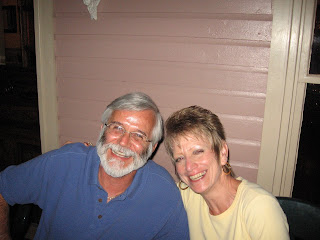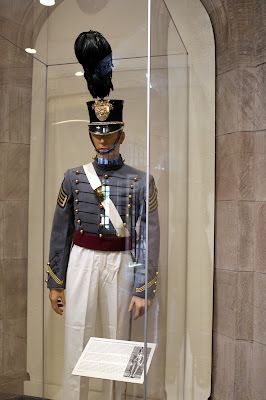We did a day trip to Hyde Park, NY to tour the Home of Franklin D. Roosevelt National Historic Site and his Presidential Library and Museum. This is the third Roosevelt site we have visited. In 2010 we toured Campobello Island in New Brunswick where the Roosevelt family had a summer home. It was here that FDR was stricken with polio while on vacation. Last summer we stopped at Warm Spring, GA to tour Roosevelt's Little White House. It was here where he went to get therapy for his polio and also where he died.
Statue of Franklin and Eleanor who were married in 1905. Eleanor. who was his fifth cousin once removed, was given away by her uncle Teddy who was then president.
Springwood was the home where Franklin D. Roosevelt was born on January 30, 1882. The home which was purchased by his father in 1867 included a working farm. The two wings and the third floor were added to accommodate the growing family of Franklin and Eleanor.
This is the home before the additions were added.
The stable and carriage house. One of their horses stabled here was named New Deal in honor of FDR's Depression recovery programs.

Since it was always Roosevelt's plan to turn the house over to the National Park Service it is exactly as it was when he died in April, 1945. This is a collection of political cartoons.
The library was part of the additions that Franklin designed. It is where he spent most of his time when in Hyde Park.
In 1921 after Franklin contracted polio and was confined to a wheelchair this lift, that was once used to move travel trunks, was used by him to get to the second floor. Part of his therapy was to strengthen his upper body, so he pulled the ropes himself to use the lift. Of the thousands of pictures taken of Roosevelt only four show him in a wheelchair.
Franklin's bedroom on the second floor. To get there he needed to use the lift and a ramp to get to this room. The balcony off this room had a great view of the Hudson River Valley.
This is Eleanor's bedroom which she used after Franklin contracted polio. It was much smaller and she did not spend much time there. Franklin's mother also had a room next to these two. Eleanor always felt that this was not her home but her mother-in-law's and they did not get along well. Eleanor had her own home nearby and she moved there as soon as Franklin died. That home is also a park service site but we did not have time to tour it on this visit.
The Roosevelt Library and Museum is the first presidential library and the only one used by the president while still in office. When construction started, Roosevelt had planned to make it his office after his second term ended. After he was elected to a second and third term, it became his office as well as an archive for his presidential documents.
Franklin, under the flag, and Eleanor, who died in 1962, are buried in the rose garden.
The Freedom Court is a tribute to Franklin Roosevelt and Winston Churchill who worked so closely during WWII to defeat the fascists. The four freedoms that they strove for were, free speech and religion and freedom from hunger and fear. But soon after the WWII the Cold War started leading to the building of the Berlin Wall that did not come down until 1989. The sculpture in the middle, Break Free, built using pieces of the Berlin Wall was created by Edwina Sandys, the granddaughter of Churchill.
This mobile sculpture symbolizes Roosevelt's love of sailing and the wheelchair he spent most of his life in even as he served as president through one of the most difficult times in our history.
Wonder if this will be the goal of the administration if "he who shall not be named" is elected in November.
A large section of the museum is dedicated to displays of the New Deal programs he put in place to put people back to work during the Depression and creating the social safety net we still count on today.
This is the office that Roosevelt used during his life when he was in Hyde Park. Originally he thought it would be his post presidency office.
Part of the section about WWII was an exhibit about the decision by Roosevelt to intern Japanese Americans in camps because of the war. Interestingly, it talks about the fact that Eleanor was opposed to the idea though she never made her opinion public during the war.
Roosevelt's White House desk. The museum also has a display about the relationship between Franklin and Eleanor and the romantic affairs that both of them are believed to have had.
The last section of the museum deals with the life of Eleanor. In addition to being First Lady, she played a major role in helping Franklin deal with his paralysis. After his death she continued her work as a social activist and served as the United States Delegate to the United Nations General Assembly from 1945 to 1952.
Here are the government programs started by President Roosevelt during his years in office. They are all things that we still have today that help the poor and middle class. making the U.S. the great country it is today.
The Roosevelt home, library and museum is a great stop to learn more about the man who was born into great wealth, but spent his life working to improve the lives of all people. We intend to return to see Eleanor's home and the Vanderbilt Mansion, two other park service sites in Hyde Park.
Just down the road from Hyde Park in Poughkeepsie is the most unique rails to trails project we have ever seen, this 1889 railroad bridge. The 6,768 foot long bridge is 213 feet above the Hudson River.
The view of the river valley from the bridge is beautiful and worth a walk above the Hudson.
There is so much more to see and do in this area of New York and we definitely plan to make a return visit.





















































